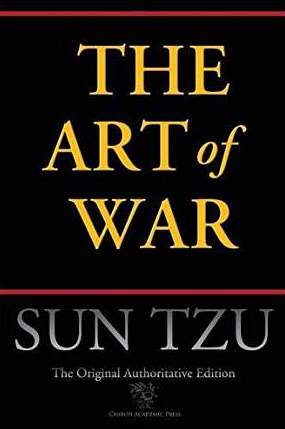Lessons from "The Art of War" for Project Management Success (II)
Five Success Factors in Practice

The Art of War is one of the most ancient books on strategy and one of the most famous books of all times. On the surface, it is about how to win a war but a lot of what is said is applicable to project mangement.
In part two of our series about the probably most ancient book about strategy, we will talk about the five measures and how to apply them to foster your project management success.
After listing the five measures, we have introduced to you in part one of our series, Sun Tzu provides an explanation of each of the elements. He uses contrasts and groups elements together to explain how to apply his concepts to real life.
The five measures in practice
If this seems a bit daunting, consider the way the none of the traditional elements that make up a true project plan (Charter, Risk Plan, Communications Plan, Project Schedule, etc.) provide as complete an explanation of what the project entails individually as they do when grouped together.
The Tao (The Way)
Sun Tzu explains The Tao (or The Way) as the thing that unites men with the mind of the person leading them in an unwavering way, despite the threat of death. For a project, or an organization, this would extend beyond a mission or vision statement into how it plays out within the culture of those involved, either uniting them, or not.
Heaven (The Political Environment)
In defining Heaven and Earth, which I defined as being akin to the Political Environment and the Organizational Structure, they are respectively explained as a balance of opposites and measures and a cycle of seasons.
When applied to a political environment, the cyclical, dynamic but dependable state of the four changing seasons gives context to the listing of the opposites above.
The political nature of an organization will always be in flux. There will always be opposing forces, but the dynamically shifting nature of that balance is something to be relied upon and carefully monitored. So, regardless of what type of political situation you face, you can always depend on the fact that change is coming and no matter how things are balanced today, they will be different tomorrow. Trust in the change, not in the state.
Earth (The Organizational Structure)
The organizational structure, or Earth, is defined in a list of actual measures:
… Height and depth,
Distance and proximity
Ease and Danger…
While it may be simpler to see, it is no less critical than the political environment/Heaven. Because it is less abstract, it can be examined in a more exact way, using more tangible metrics. However, Heaven and Earth are paired in the Art of War. The organizational structure and political environment can’t be seen individually. They are a pair, and moreover, as part of the five measures, just two of the ways we experience that with which we are interacting.
Command (Leadership)
In explaining what he means by Leadership, or Command, Sun Tzu provides a list of ingredients: Wisdom, Integrity, Compassion, Courage and Severity.
I have always worked under the assumption that these have been listed in a particular order based on the overall importance of each to organizational maturity (with Wisdom being prized above all and Severity as the lowest ranking critical value), but that may just be me.
Either way, if you were to examine an organization and rate them along each of these points, you would be able to develop a fairly clear understanding of the overall value system and (arguably) maturity of that organization.
Discipline
Discipline is perhaps the easiest of the five measures for a project manager to understand. It is defined as…
- Organization
- Chain of command
- Control of expenditure
This is a simple, concrete explanation.
Sun Tzu emphasizes that every leader is aware of the five measures, but there is a difference between being aware and truly understanding them.
According to The Art of War, there are five vantage points from which you should be studying any organization/company/opportunity/opponent/insert name of thing you are facing that you are scared of or do not understand here.
If you study the five measures for your situation to a point where you have true clarity on each of them, then by your very understanding of them, you will succeed. However, if you don’t, by your very lack of understanding, you will fail.
Make sure that you have already won
Having defined that which is to be measured, Sun Tzu provides examples of things to be considered when examining the five measures.
He recommends determining which leader has captured the cultural mindset and which has the poitical and organizational advantage. Who has the strength and rigorous enough approach to discipline to follow the processes they have defined as their path to success.
According to Sun Tzu, understanding these will help you “know” victory and defeat. This is an important point to spend some time on. The idea is not that if you study these things, you’ll win; but that if you study these things, you will be able to foresee who will win… which leads to a principle introduced later that is (simplified) never take on a battle you have not already won.
Following this thought, if you stick with Sun Tzu, follow his rules, he promises to lead you to victory. If you follow his guidelines, the Art of War will get your back and keep you from harm. However, this is going to include knowing when to back down, when to back away and when to take action in a way that is decisively final. In the workplace, my experience has been that the last part if often more difficult for people to adopt than the backing down.
Why you need total commitment
Sun Tzu also goes on to explain that if you don’t adhere to these rules, whether you use the Art of War or not, you’ve already ensured you will fail. This is another critical point in the Art of War. What Sun Tzu has essentially done is stated that if you stick with him 100%, he’ll guarantee success, anything less than that, and you are not using the Art of War and you will fail. For those familiar with Scrum, this would be “The Art of War, but…” and it has about the same chances of success as “Scrum, but…”
This level of commitment is something that appears a number of times throughout the book. It can seem a bit severe when put into practice, but it is something that truly differentiates practitioners of the AOW from those who merely dabble in it. Because war is such nasty business, once you have committed to it, Sun Tzu demands total commitment. At times, this means backing down and at times it can mean pushing further than you might normally. Even taking the time to determine, for yourselves, where the line is in terms of what you are willing to do in order to help the project succeed, can be helpful.
Conclusion
As Sun Tzu says, we must know our opposition and ourselves to succeed. Often, the trick for us as PMs is to make sure there is a difference between the two.
In the next part of our series you will learn how to use the tao of paradox to your advantage as a project manager.

